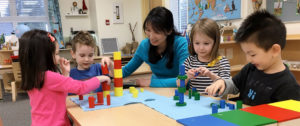Many moms in Dublin, California, and the surrounding area – Pleasanton, in particular – want to return to work when their children reach the age of two or three. In some cases, those moms may have a need to return to work. Either way, this is where our Dublin daycare options come in at Learn And Play Montessori.  This is the ideal way to get your child’s education off to a flying start, and it sets the foundation for preschool and beyond.
This is the ideal way to get your child’s education off to a flying start, and it sets the foundation for preschool and beyond.
We take children from the ages of two up to six at Learn And Play Montessori, and we take special care of our toddlers. One of the big advantages of our Dublin daycare for working moms is that we open at 7.00 am and we stay open until 6.30 pm, so whatever your working hours are, we fit in with them.
We have a huge choice of Montessori materials in each of our five large and airy classrooms, and each child is free to look around and find something that interests him or her. There is no rush and absolutely no pressure: the kids can look around and get involved with whatever material they wish. This is one of the major benefits of the Montessori method because even at that young age, each child is finding out about, and exploring something because he WANTS to do so. The result of this is that, very quickly, learning becomes something that is fun. We all love fun, and if we enjoy doing something, we want to do more of it, and this is the way the Montessori method works.
A Range Of Ages; Best Preschool Options for Each Age
Furthermore, we have a range of ages in each class. This is because of a very basic fact which is that children learn from each other. You see this in the family, where the younger child watches and learns from his older siblings. He, or she, observes the older child as a model to be copied, or in some instances, not be copied.
Having a range of ages in the classroom – usually covering a span of up to three years – helps each child to develop a sense of community and belonging, and perhaps equally importantly a sense of respect for others. There is also another advantage and that is that there is no sense of competition. Children do not compete with each other to see who is “best” but rather work and play at their own speed. There is no rush. We all know that children develop at different rates, and some are simply faster learners than others.
This leads to mutual respect for each other person in the group and the understanding that every individual has his or her own unique abilities that can contribute to the group, no matter how much or how little at any given moment.

